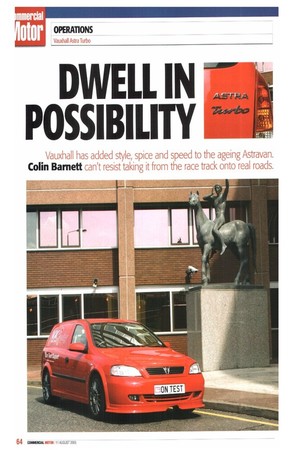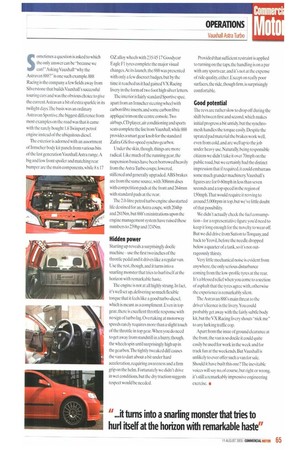DWELL IN POSSIBILITY
Page 64

Page 65

If you've noticed an error in this article please click here to report it so we can fix it.
Vauxhall has added style, spice and speed to the ageing Astravan. Colin Barnett can't resist taking it from the race track onto real roads.
Sometitnes a question is asked to which the only answer can he "because we can!" Asking Vauxhall "why the Astravan 888?" is one such example. 888 Racing is the company a few fields away from Silverstone that builds Vauxhall's successful touring cars and was the obvious choice to give the current Astravan a bit of extra sparkle in its twilight days. lbe basis was an ordinary Astravan Sportive, the biggest difference from most examples on the road was that it came with the rarely bought 1.6 Twinport petrol engine instead of the ubiquitous diesel.
The exterior is adorned with an assortment of Irmscher body kit panels from various hits of the last generation Vauxhall Astra range. A big and low front spoiler and matching rear bumper are the main components, while 8 x 17 OZ alloy wheels with 235/45 17 Goodyear Eagle Fl tyres complete the major visual changes.At its launch, the 888 was presented with only a few discreet badges, but by the time it reached us it had gained VX Racing livery in the form of two foot high silver letters.
The interior is fairly standard Sportive spec, apart from an Irmscher steering wheel with carbon fibre inserts, and some carbon fibre appliqué trim on the centre console.Two airbags. CD player, air conditioning and sports seats complete the list from Vauxhall, while 888 provides a smart gear knob for the standard Zafira GSi five-speed synchro gearbox.
Under the skin.though. things are more radical. Like much of the running gear, the suspension basics have been borrowed heavily from the Astra Turbo coupe, lowered, stiffened and generally upgraded.ABS brakes are from the same source, with 308mm discs with competition pads at the front and 264mm with standard pads at the rear.
The 2.0-litre petrol turbo engine also started life destined for an Astra coupe, with 204hp and 281Nm, but 888's ministrations upon the engine management system have raised these numbers to 239hp and 324Nm.
Hidden power
Starting up reveals a surprisingly docile machine — use the first two inches of the throttle pedal and it drives like a regular van. Use the rest, though, and it turns into a snarling monster that tries to hurl itself at the horizon with remarkable haste.
The engine is not at all highly strung. In fact, it's well set up, delivering so much flexible torque that it feels like a good turbo-diesel, which is meant as a compliment. Even in top gear, there is excellent throttle response with no sign of turbo lag. Overtaking at motorway speeds rarely requires more than a slight touch of the throttle in top gear.When you do need to get away from standstill in a hurry, though, the wheels spin until surprisingly high up in the gearbox.The tightly tweaked diff causes the van to dart about a bit under hard acceleration, requiring awareness and a firm grip on the helm.Fortunately we didn't drive in wet conditions, but the dry traction suggests respect would be needed. Provided that sufficient restraint is applied to turning on the taps. the handling is on a par with any sports car. and it's not at the expense of ride quality, either. Except on really poor surfaces, the ride, though firm, is surprisingly comfortable.
Good potential
The revs are rather slow to drop off during the shift between first and second, which makes initial progress a bit untidy, but the synchromesh handles the torque easily. Despite the uprated pad material the brakes work well, even from cold, and are well up to the job under heavy use. Naturally, being responsible citizens we didn't take it over 70mph on the public road, but we certainly had the distinct impression that if required, it could embarrass some much grander machinery.Vauxhall's figures are for 0-60mph in less than seven seconds and a top speed in the region of 150mph.That would require it revving to around 5,000rpm in top, but we've little doubt of that possibility.
We didn't actually check the fuel consumption— for a representative figure you'd need to keep it long enough for the novelty to wear off. But we did drive from Sutton to Torquay.and back to Yeovil, before the needle dropped below a quarter of a tank, so it's not outrageously thirsty.
Very little mechanical noise is evident from anywhere, the only serious disturbance coming from the low-profile tyres at the rear. It's a blessed relief when you come to a section of asphalt that the tyres agree with, otherwise the experience is remarkably silent.
The Astravan 888's main threat to the driver's licence is the livery. You could probably get away with the fairly subtle body kit,but the VX Racing livery shouts "nick me" to any lurking traffic cop.
Apart from the issue of ground clearance at the front, the van is so docile it could quite easily be used for work in the week and for track fun at the weekends. But Vauxhall is unlikely to ever offer such a van for sale. Should it have built this one? The inevitable voices will say n o, of course, but right or wrong, it's still a remarkably impressive engineering exercise. •


































































































































































































